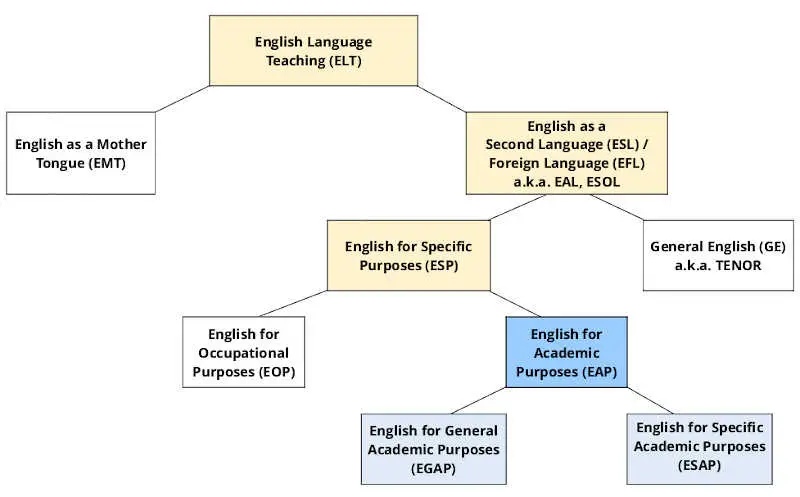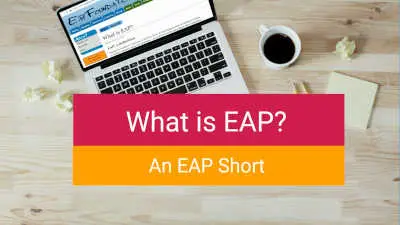Show AWL words on this page.
Show sorted lists of these words.


 







|
 Podcast is loading. Too slow? Click here to access.
Podcast is loading. Too slow? Click here to access.
This page gives a definition of EAP, describes the development of EAP, locates EAP in a family tree of English Language Teaching, considers general versus specific EAP, and compares EAP to General English.
EAP: a definition
English for Academic Purposes, or EAP for short, is the English which is needed to study or conduct research using that language. It is most commonly associated with preparation for undergraduate study, via short (4-12 week) pre-sessional courses, i.e. ones which take place before the study begins, though many other EAP contexts exist, including courses to prepare students for post-graduate study, longer courses such as foundation year programmes, and courses which take place at the same time as the study, called in-sessional courses.
The development of EAP
The term EAP was first used in 1974, when it was a minor branch of English Language Teaching (ELT). It has grown enormously in the years since, mainly due to the internationalisation of higher education and the increasing use of English as the language of academic knowledge exchange. EAP has had its own professional body since 1972, originally called SELMOUS (Special English Language Materials for Overseas University Students), which changed its name in 1989 and is now known as BALEAP (The British Association of Lecturers in English for Academic Purposes), which supports the professional development of English for Academic Purposes. EAP has its own professional journal, the Journal of English for Academic Purposes (JEAP), first published in 2002.
A family tree of ELT
Another way to understand EAP is by viewing it in the family tree of English Language Teaching (ELT), as shown below (based on Hutchinson and Walters, 1987). ELT can be divided into English as a Mother Tongue (EMT) and English as a Second Language (ESL) or English as a Foreign Language (EFL), depending on whether it is studied in an English speaking country (ESL) or not (EFL). EFL/ESL are sometimes referred to by other names, for example EAL (English as an Additional Language) and ESOL (English for Speakers of Other Languages), in deference to the fact that for many learners, English is not the second but the third, fourth or more language they have learnt. ESL/EFL can be sub-divided into General English (GE), and English for Specific Purposes (ESP). General English, which is mainly for exam purposes, is the form learners are most familiar with, since it is the kind of English taught in schools. Due to the fact that most GE students are too far from real communication in English to have any real need to study it, GE is sometimes referred to as TENOR (Teaching English for No Obvious Reason), which directly contrasts it with ESP, for which there is a specific purpose. ESP can be sub-divided into English for Occupational Purposes (EOP), for example English for business or English for law, and English for Academic Purposes (EAP).
The diagram below outlines this family tree of ELT.

General vs. Specific EAP
EAP itself can be sub-divided according to whether its content is general (EGAP, short for English for General Academic Purposes) or specific (ESAP, short for English for Specific Academic Purposes). Whether an EAP course is general or specific will often depend on the students in the class: if they are students who study or will study a range of disciplines, then the course will usually be more general; however, if the students study or will study a common discipline, for example Engineering, then the content will often be more specifically tailored to their needs, for example by including laboratory report writing. Many EAP teachers and writers consider EGAP to be synonymous with study skills, since these courses cover areas such as note-taking, referencing, and taking part in discussions, which are traditionally seen as study skills areas (though on this website, they are included in sections according to the area of English, e.g. the writing section for referencing, the speaking section for discussion skills).
EAP vs. General English
The difference between EAP and General English (GE) has been briefly outlined above. As mentioned, GE is the form of English learners (and beginning EAP teachers) are usually most familiar with. Understanding how General English and EAP differ will assist students and teachers as they transition from the former to the latter.
Two fundamental areas of difference are the aims of the courses and reasons for study. The aims of an EAP course are to meet the needs of particular learners. This contrasts with GE, which has the aim of improving overall English ability in different areas (reading, speaking, vocabulary and so on). The reason why students study EAP is because they study or plan to study another subject in English. They may need to study EAP in order to gain admission to university. GE, on the other hand, is studied because it is a compulsory course (e.g. at school), or because it interests them (e.g. adult evening classes).
A third difference, shaped by the previous two, is the focus of the course. Unlike GE courses, which are level driven and focus on language, EAP courses are driven by needs, and focus on the learner and the situation. A needs analysis is a core component when designing any EAP course.
Another difference is the timeframe. EAP courses tend to be very short courses, covering a fixed timeframe, for example 4-12 week pre-sessional courses. GE courses, in contrast, can be more flexible, and may cover many years of study. As a result of the short timeframe and reasons for study, EAP courses tend to be very high stakes, with entry to university depending on the result, while GE courses are much lower stakes.
There is also a difference in terms of skills focus. EAP courses tend to devote more time to reading and writing, since these are the most important skills for academic study, and for learning and assessment at university. In contrast, GE courses tend to give more time to speaking and listening.
The text types and approach also differ. EAP generally uses authentic, academic texts, which are genre based and, because of their complexity, tend to be explored more fully. GE texts, on the other hand, are often chosen because the topic is interesting, and are usually not explored in great depth. They tend to be conversational or social in nature.
The form of expression is another area of difference. In EAP, clarity and objectivity are prized, in contrast to GE, for which self expression and creativity are usually important.
Another difference is the role of the teacher. In EAP, the role of teacher and student are usually more equal. The teacher brings language expertise and knowledge of teaching to the classroom, while students may be more knowledgeable about their own specialist subject, which will be important if an ESAP approach is used and the texts contain subject specific information. This situation is different from a GE course, for which the teacher is seen as the language expert.
A final difference is the range of learning skills involved. In EAP, there will almost always be a strong emphasis on study skills, in particular learner autonomy and critical thinking. In a GE class, by contrast, there may be no focus on learning skills; if learning skills are covered, they tend to be limited to language learning skills, and may not be a significant part of the course.
A summary of these differences is given in the table below.
| Aspect | EAP | General English |
| Aims | Meet the needs of particular learners | Improve overall English |
| Reason for study | To study another subject in English, to enter university | Compulsory, or for interest |
| Course focus | Needs driven, begins with learner and situation | Level driven, begins with language |
| Time | Short, fixed | Extended, flexible |
| Stakes | High stakes | Low stakes |
| Main skills focus | Reading and writing | Listening and speaking |
| Text type and approach | Authentic, academic, genre based, explored fully | Interesting, conversational/social, topic based, not explored fully |
| Style of expression | Clarity, objectivity | Self expression, creativity |
| Role of teacher | Equal | Expert |
| Learning skills | Study skills, especially learner autonomy and critical thinking | None, or limited to language learning skills |
Summary
In short, EAP is the English which is needed to study or conduct research using that language, seen most often in short pre-sessional courses to prepare for undergraduate study, though also occurring in many other contexts. EAP has developed rapidly since the term was first used in 1974, and it now has its own professional organisation (BALEAP) and journal (JEAP), which will ensure its continued development. In terms of English Language Teaching, it is viewed as a branch of ESP, and differs markedly from General English. EAP itself comprises a general form (EGAP), which is the one that most of this website covers, as well as a specific form (ESAP).
References
Abbot, G. (1981) 'Encouraging communication in English: a paradox', ELT Journal, 53(3).
Alexander, O., Argent, S. and Spencer, J. (2008) EAP Essentials: A teacher's guide to principles and practice. Reading: Garnet Publishing Ltd.
BALEAP (2019) About Us: Key information about BALEAP's aims. Available at: https://www.baleap.org/about-baleap/about-us (Access date: 27/11/19).
Hamp-Lyons, L. (2011) 'English for Academic Purposes', The Cambridge Guide to Teaching English to Speakers of Other Languages, DOI 10.1017/CBO9780511667206.019.
Hutchinson, T. and Walters, A. (1987) English for Specific Purposes: A learning-centered approach. Cambridge: Cambridge University Press.
Hyland, K. (2006) English for Academic Purposes: An advanced resource book. Abingdon: Routledge.
Jordan, R.R. (1997) English for Academic Purposes: A guide and resource book for teachers. Cambridge: Cambridge University Press.
Next section
Find out about teaching EAP in the next section.
Previous section
Go back to the previous section which contains information about the website.






